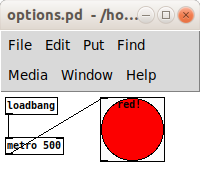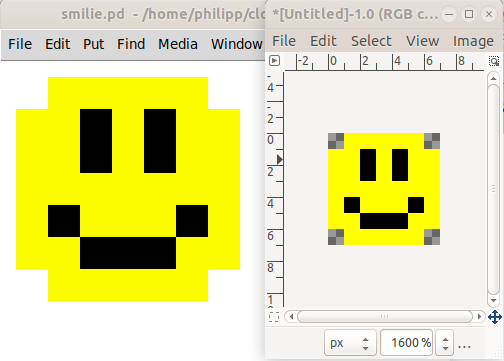Tutorial
- Start PureData
- Create Patches
- Nodes
- Node Arguments
- Options
- Inlets and Outlets
- Referencing Nodes
- Connecting Nodes
- Colors
- Images
Start PureData
PureData can be started by calling startup.
(Make sure that the pd executable can be found in your PATH.)
When started this way, it will automatically load a patch that establishes a connection to clj-puredata.
You can then load patches by calling load-patches.
If these patches are later updated / rewritten using write-patch-reload, they will automatically be reloaded in PureData as well.
(startup) ; Start PureData.
(startup "test.pd") ; When supplied with an argument, clj-puredata tries to load the patch immediately.
; This will fail when PureData takes longer than 3 seconds to start. Sorry!
(load-patches "test.pd") ; This is another way to load one or multiple patches.
(load-patches "one.pd" "two.pd") ; etc.
Create Patches
Patches are created using write-patch or write-patch-reload.
When a patch has previously been opened in PureData using load-patches, then evaluating write-patch-reload will reload that patch in PureData automatically.
A number of options can be supplied to customize the patch itself - see the list of options.
(write-patch
"filename.pd" ; First argument is the patch filename.
{:width 300 :height 200} ; The second argument can (optionally) be an options map.
[:print [:float 0 [:loadbang {:name 'onLoad}]]] ; Any other arguments are treated as nodes.
[:msg "loading" (other 'onLoad)]
...
)
Nodes
Nodes are created from vectors like [:+ 1 2].
The first element must always be a keyword like :print or a string like "subpatch.pd".
Signal nodes always end with a dash - (not a tilde ~), like [:osc- 440].
A list of supported nodes and their names can be found in Nodes.md
(write-patch "basics.pd"
; Nodes are created from hiccup-inspired vectors.
; (see https://github.com/weavejester/hiccup#syntax)
[:-] ; The first item is always the node name, as a keyword.
[:+ 1 2] ; Literals (numbers, strings) are passed as creation arguments.
[:msg "bang"]
[:* [:msg 3]] ; Nesting nodes creates connections between them.
; Note these special cases:
["subpatch.pd"] ; If the first item is a string, it will render as a subpatch.
[:*- 1 [:osc-]]) ; Signal nodes have a `-` (dash) (instead of a `~` (tilde)) appended to their name.
; (This is because tilde has special meaning in Clojure.)

Node Arguments
Inside a node vector, everything that isn’t the first item, or an options map as the second item, is treated as an argument.
If the argument is a literal number or string, those are used verbatim.
If the argument is another node, a connection is formed.
For nodes, the position of arguments determines the target inlet (unless otherwise specified using inlet).
(write-patch "arguments.pd"
[:pack \f \f ; Argument position determines the connection inlet:
[:msg 1] ; Connected to first inlet.
nil ; `nil` skips an inlet.
\f ; Literals don't influence inlet count and are concatenated regardless of position.
[:msg 3]]) ; Connected to third inlet.

Options
Options can be passed as the second argument to both Nodes (through hiccup) and Patches (through write-patch etc.).
You can find a list of supported options in the List of supported Options.
These are relevant for UI nodes like Sliders, Toggles, Bangs etc., and also contain the graphing options for subpatches.
(write-patch "options.pd"
{:width 200 :height 80} ; Set patch options as the second argument to `write-patch`.
[:bng {:name 'b ; Set node options as the second element in hiccup vectors.
:x 100 :y 5
:size 64
:label-text "red!"
:fg-color -258049}
[:metro 500 [:loadbang]]])

Inlets and Outlets
To specify which inlet or outlet two nodes connect on, use the inlet and outlet functions.
(write-patch "inlet-and-outlet.pd"
[:pack
(inlet [:msg "second inlet"] 1) ; Specify target inlet explicitly with `inlet` function.
(inlet [:msg "first inlet"] 0)]
[:print "over 9000" (outlet [:moses 9000] 1)] ; Specify target outlet explicitly with `outlet` function.
[:+ 1 (inlet (outlet [:select 3] 1) 1)]) ; `inlet` and `outlet` can be combined.

Referencing Nodes
TODO: show how let and pd can be used to reference nodes.
(write-patch "other.pd"
[:loadbang {:name 'lb}] ; Giving Nodes a `:name` allows them to be referenced by `other`.
[:print "loaded!" (other 'lb)]
[:print "zero" (other 'm)] ; The named Node can be defined later, too.
[:print "one or more" (outlet (other 'm) 1)] ; `inlet` and `outlet` also work with `other`.
[:moses {:name 'm} 1])

Connecting Nodes
(write-patch "connect.pd"
(connect [:loadbang] [:print "hello world!"]) ; Use `connect` to connect nodes explicitly.
(connect [:moses] 1 [:pack] 1) ; Use 4 arguments to specify inlet and outlet ...
(connect (-> [:select] ; ... or use `inlet` and `outlet` explicitly.
(inlet 1) ; Note: they are used on the originating node.
(outlet 1))
[:pack])
[:msg {:name 'tik} "bang"]
[:metro {:name 'tok} 200]
(connect (other 'tik) (other 'tok))) ; It works fine with `other` as well.

Colors
(let [hues 32
size 18
width (+ 32 (* hues size))]
(write-patch
"colors.pd"
{:width width
:view-width width
:view-height 32 :graph-on-parent 1}
[:msg "; all-bangs color $1 0 0"
(inlet [:msg (color-runtime 255 0 0) [:msg "red"]] 0) ; Use `color-runtime` for sending color values during runtime.
(inlet [:msg (color-runtime 0 255 0) [:msg "green"]] 0)
(inlet [:msg (color-runtime 0 0 255) [:msg "blue"]] 0)]
(map #(vector :bng {:x (+ 16 (* % size)) :y 5
:receive-symbol "all-bangs"
:bg-color (color-file ; Use `color-file` for color values stored in the file.
(hsl2rgb (/ % hues) 1 0.5))}) ; Helper function `hsl2rgb` is available.
(range hues))))

Images
(write-patch "smilie.pd"
(import-image "smilie.png" 32)) ; Turns a PNG image into colored canvasses.
